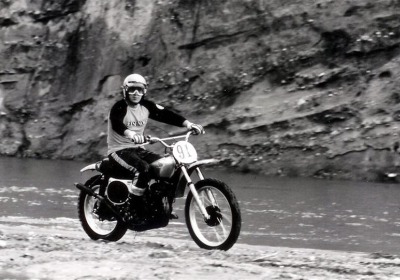Why Steve McQueen canceled a $3 million life insurance policy
Fri, 25 Apr 2014
Spurred by the story of our ride in Steve McQueen's Jaguar XKSS, Richard Haight felt inclined to chime in with the fact that he not only raced motorcycles with (and against) McQueen, but knew him all the way until the King of Cool's death.
Haight raced motorcycles on and off for 50 years. McQueen would come and race at the local American Motorcycle Association District 37, usually entering under assumed names like "Harvey Mushman" to enjoy some semblance of normality.
"I also road-race sidecars," said Haight, "and on occasion he would hang around with us, especially during events like the Elsinore Grand Prix. As a motorcycle racer and photographer for Motorcycle Weekly, I was present during a lot of the events depicted during 'On Any Sunday,' like the Elsinore Grand Prix and various AMA professional dirt-track events such as the Santa Rosa Mile.
"We all used to hang out at Ekins' Triumph shop on Ventura Boulevard, near Van Nuys Boulevard in Sherman Oaks. One of our SideHack members, Ernie Aragon, was the racer who raced the Elsinore Grand Prix wearing a pink bunny suit, and throwing candy to the kids along the course!"
Years later, Haight would put his racing aside and become an insurance adjuster, an ironic twist given his personal risk-management tendencies. The firm he worked for just happened to have his old racing buddy, McQueen, as a client. Haight claims McQueen bought a large life insurance policy from him, to the tune of $3 million, maintaining the policy through the entirety of the 1970s, even as he found himself dying of mesothelioma.
Mesothelioma is a nasty disease -- the effects of asbestos inhalation can lie dormant for 30 or 40 years before showing symptoms. It's often rumored that McQueen exacerbated the disease from his racing suits, but the reality is those were made from Nomex even back then -- instead, his condition most likely came from removing asbestos from ships while in the Marines. McQueen's first symptoms presented in 1978. In early 1980, the doctors told him that the metastasis had spread, radiotherapy and chemo could do little more, and there were no more options.
McQueen thought otherwise. He fled to Rosarito Beach, Mexico, where he met William Donald Kelley -- a quack orthodontist who prescribed the actor a routine of coffee enemas, massage, frequent shampooing, daily injections of fluid derived from cow and sheep fetuses, and laetrile, a supposed anti-cancer drug made from apricot pits. McQueen spent his days taking vitamins, attending prayer sessions, confessing to psychotherapists, and basically following Kelley's word to the letter. Never mind that Kelley had been blacklisted by Sloan-Kettering and the American Cancer Society and that his treatments "showed a decrease in overall survival and poorer quality of life," according to the former.
In the 1980s Kelley's life would fall apart and he would descend into madness -- at one point, Kelley claimed that McQueen had fully recovered but was killed because he "was going to blow the lid off of the cancer racket."
McQueen, of course, fared even worse. He passed away on Nov. 6, 1980. His ashes were scattered into the Pacific Ocean.
"Around the time he decided to go to Mexico," said Haight, "he decided to terminate the policy, and told me that he had 'come up the hard way, and he wanted his kids to do the same...' As it was known by then that he had serious cancer, with a significant possibility that it might be terminal, it seemed like a stupid decision, and I told him so. What is the point of working to achieve something for yourself and your children, i.e. to better your lives, and then just throw it away?
"Nevertheless the policy was terminated and he died a while later without it."
Fortunately, McQueen's vast estate of cars and motorcycles (to the tune of 138 motorcycles and 35 cars, according to one interview), their values no doubt exaggerated with celebrity power, helped support his son and daughter.
Haight moved on to another insurance firm. And in the mid-1990s, through the myriad twists and turns of insurance merging, Haight found himself an insurance adjuster for -- of all people -- Chad McQueen.
Image via Steve McQueen Online.
By Blake Z. Rong

